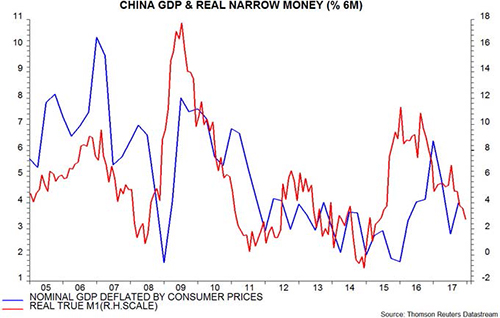
Janus Henderson: Chinese money trends signalling weaker outlook
Chinese economic growth remained solid in late 2017, as had been suggested by narrow money trends through the summer. The latest narrow money numbers, however, were notably weaker – barring a swift reversal, the suggestion is that economic prospects are darkening.
19.01.2018 | 12:20 Uhr

Officially-reported real GDP rose by 6.8% in the year to the fourth quarter, beating a consensus forecast of 6.7%. Growth was supposedly equal in the first and second halves.
Nominal GDP, deflated by consumer prices, is probably a better guide to “true” activity*. Two-quarter growth of this measure peaked in the first quarter of 2017, fell back in the second and third quarters but staged a partial recovery in the fourth. A second-half slowdown had been predicted by six-month real narrow money growth, which fell significantly between August 2016 and January 2017. Real money growth, however, stabilised between January and September at a respectable level by historical standards, suggesting that economic momentum would remain solid into early 2018 – see chart.

The reassuring signal from narrow money trends through September contradicted forecasts that monetary and regulatory policy tightening would lead to a significant economic slowdown by end-2017. Followers of the “credit impulse”, in particular, have been too negative.
Real narrow money growth, however, fell further over October-December and is now in the lower half of its range in recent years. Unless money growth bounces back, the suggestion is that the economy will lose momentum in the spring / summer.
Narrow money trends usually lead house prices, industrial profits and producer prices – all three are likely to slow in early 2018. On past form, the authorities would be expected to respond by starting to reverse policy tightening. Such a policy reversal would be a surprise to the consensus and could give a short-term boost to commodity prices.
The risk is that policy-makers are now prioritising limiting credit expansion and financial risks and will be slow to step off the brakes, in which case monetary trends – and economic prospects – may continue to deteriorate in 2018.
*Consumer prices are an unsatisfactory proxy for GDP deflator but this distortion may be less significant than the “smoothing” incorporated in official real GDP data.



Diesen Beitrag teilen: